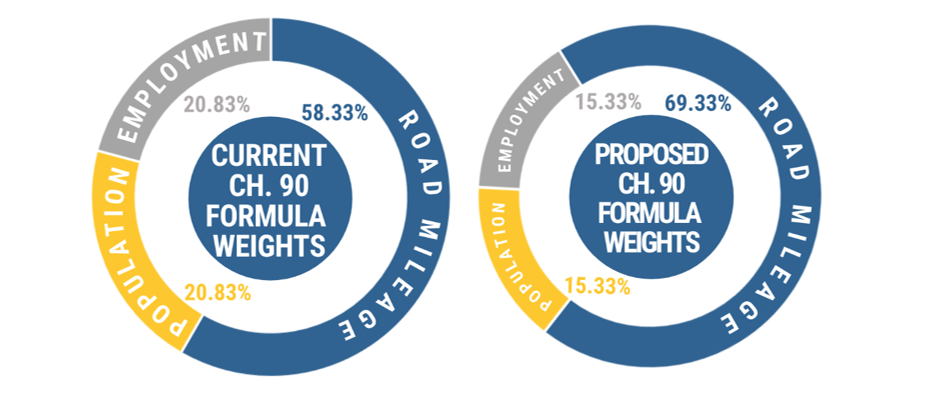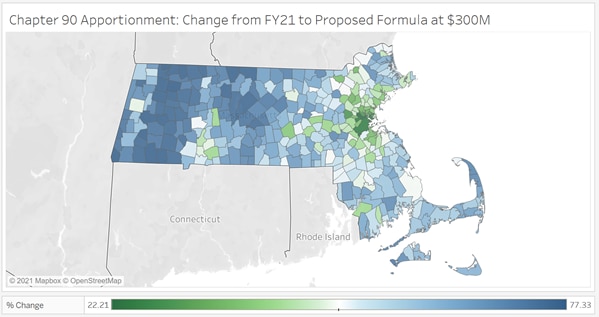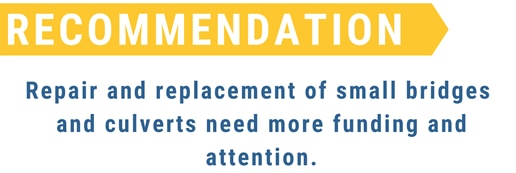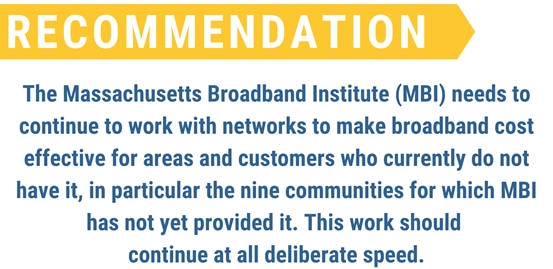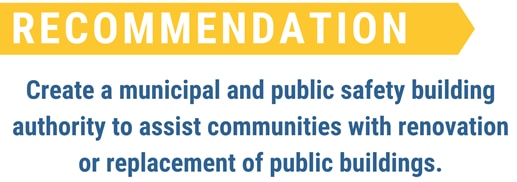Overview
While the research and survey explored the challenges of public infrastructure through the lens of Western Massachusetts, the recommendations will apply across the Commonwealth and address challenges seen universally among its municipalities. There are a variety of avenues available to finance the following recommendations. Increased funds for roadways may be forthcoming through proposals at the federal level to invest $550 billion in new spending into infrastructure, including $110 billion in funds for roads, $14 billion for bridges, and $16 billion for major infrastructure projects.158 The American Rescue Plan Act provides $8.7 billion in funds to state and local government in Massachusetts for expenditures over a multiyear period with the potential for funds to be used for infrastructure. In Massachusetts, there is a forthcoming ballot question about whether to institute a 4% tax on earned income over $1 million, which would generate up to $2 billion annually for transportation and education funding.159 The Tax Expenditure Review Commission released a report in March 2021 that recommended various changes to state tax collections, representing millions in foregone revenue that is the subject of ongoing discussions.160
1. Transportation
The Commonwealth should invest in making transportation funding more equitable in Western Massachusetts by reforming the Chapter 90 Program funding formula and boosting funding levels, as well as providing additional funding opportunities for small bridges, culverts, and unpaved roads.
1a. Chapter 90 Program
As discussed above,161 Chapter 90 funding is the most important source of funding for roadway work across the communities of Western Massachusetts. The funding formula places weights on road mileage, population, and employment within the municipality. Section 4(b) of Chapter 6C of the Massachusetts General Laws gives the Massachusetts Department of Transportation (MassDOT) the authority to distribute money for roadways, which they do through the Chapter 90 funding formula.162 Common criticisms of the state Chapter 90 Program are that it is underfunded and that its funding formula has not been updated since its implementation in 1972.163 Criticism of the current formula is growing, as the weights for the formula benefit cities with high population and high levels of employment, particularly the city of Boston, which has the highest population of any community in Massachusetts as well as the highest number of employed people.164 In response to these concerns, Rep. William Pignatelli filed a bill in the 2021–2022 legislative session (H.3572)165 that would change the formula weights, as seen in the table below.
Figure 20—Chapter 90 Program Formula Weights, Current and Proposed
|
Current Chapter 90 Formula Weights |
Proposed Changed Formula Weights (H.3572) |
|
|
Road Mileage |
58.33% |
69.334% |
|
Population |
20.83% |
15.333% |
|
Employment |
20.83%* |
15.333%† |
* Rep. Pignatelli files bill on changing Chapter 90 Formula. 2019. Retrieved from: http://northadams.com/story/59401/Pignatelli-Files-Bill-on-Changing-Chapter-90-Formula.html
This proposal would place more weight in the formula on road miles, rather than population and employment, benefitting municipalities with smaller populations by granting them more funds. Under this proposed formula, for example, 31 of the 32 communities in Berkshire County would see their allocations increased even while maintaining the current appropriation level.167 Some communities that may lose money, being disproportionately larger, have competitive advantages over those that may gain funds, such as having professional planning and engineering staff, dedicated grant writers, and access to other funding sources for which smaller communities are ineligible.168
The Chapter 90 Program formula can also be changed administratively by MassDOT without legislation, allowing the change to be implemented more quickly. Many Western Massachusetts communities have hundreds of road miles, including bridges and culverts that are costly to replace. By shifting funding to these communities, they would be better able to maintain this infrastructure and enhance the attractiveness and livability of their towns. MassDOT should use its administrative authority to enact changes to the Chapter 90 Program formula consistent with the percentages contained in H.3572.
In the absence of a significant increase of Chapter 90 funding to accompany this change, money would be shifted away from population centers like Boston, which would lose $1.4 million under the new proposed formula weights.169 To address this issue, overall Chapter 90 funding should be increased to allow more projects, in both large and small municipalities, to be funded. A solid mechanism for this transition is the proposal supported by the Massachusetts Municipal Association that increases the annual appropriation to $300 million and funds the program over a two-year window. As shown below in Figure 21, this would provide all communities with an increased apportionment, even if the formula was shifted to place more weight on road mileage.
Greater investment in the Chapter 90 Program and a shift to the formula present a scenario where all communities would gain funding, with the greatest effects felt in Western Massachusetts. Coupled with a biennial apportionment, this allows for greater certainty of funding and better planning for communities over the construction cycle. The state should also consider a hold-harmless provision for Chapter 90 funding to further ensure that communities do not lose funds over time. For example, the town of Lenox in Berkshire County received $436,051 in fiscal year (FY) 2015, but that amount had declined over 35% to $282,098 in FY 2020.160 Overall, all communities in the state would benefit from this higher level of funding.
Furthermore, the four counties of Western Massachusetts have networks of unpaved roads which have gravel or dirt surfaces. There is some confusion among stakeholders regarding which sources of funding are available to help maintain, repair, and replace these roadways. The Commonwealth should publicly catalogue revenue streams that are available for unpaved roads and consider these roadways for additional funding, given the increased risk of storms and flooding from climate change. A proposal introduced by Sen. Adam Hinds (S.2337) during the 2021–2022 legislative session would establish a working group that would identify and evaluate gaps in funding, as well as existing funding streams, to support the maintenance and improvement of unpaved roads and paved low-volume roads.170
1b. Small Bridges and Culverts
Western Massachusetts has over 2,000 small bridges and culverts, some of which are in poor condition.171 Given the large number of culverts and small bridges that need repair and replacement, the Small Bridge and Culvert Program dedicated to this challenge should be significantly expanded. This is another area for critical design and engineering assistance and compounds a growing need to account for flooding and drainage issues for roadways, particularly in light of the adverse impacts of climate change. In order to assist with the design and engineering of small bridges and other projects, MassDOT, or regional planning agencies, should provide technical assistance to municipalities in the form of engineering and planning expertise, which will require greater resources. These experts housed within MassDOT, or regional planning agencies, could unlock funding for smaller municipalities that cannot spend funds towards design requirements and feasibility studies, while also lowering the municipal burdens for infrastructure development. The Culvert and Small Bridge Working Group endorsed an effort, already underway within MassDOT, to create design templates for stream crossings that could potentially lower the costs of engineering these projects. As MassDOT and regional planning agencies are often involved in the approval process for infrastructure funding, there should be a firewall between this technical expertise and the various funding arms of these authorities to lessen the appearance of a conflict of interest among competing potential grantees. Alternatively, technical assistance programs could be housed elsewhere, such as in the Executive Office of Housing and Community Development, to ensure separation.
1c. Small Town Road Assistance Program
The Small Town Road Assistance Program (STRAP), which is a stressed resource that is dedicated to the needs of small communities, should be enhanced in two ways. First, the MassWorks enabling statute should be amended to provide a larger percentage (15 or 20%) of MassWorks’s annual funding towards STRAP projects, rather than the current 10%. In addition, the $1 million cap per project for STRAP projects should be removed, which will allow larger projects to take advantage of the program.
2. Broadband and Communications Infrastructure
MBI should continue to invest in its grant programs, accompanied by requirements for providers to improve networks over time. This will necessitate continued funding of the municipal broadband networks. Such a system should motivate the network providers to provide good and reliable service that will encourage customers to enroll, while making it future-focused for technological development. Finally, steps need to be taken to create redundancy and resilience in the fiber-optic networks so damage to the lines at one point will not knock out communications for many customers at once.172
3. Municipal and Public Safety Building Authority
The Legislature should create an agency devoted to improving public building infrastructure in underserved areas, modeled on the Massachusetts School Building Authority (MSBA). MSBA works with school districts to provide them with capital funding for large portions of school construction and repair projects. MSBA is funded through a dedicated revenue stream of one cent from the state’s 6.25% sales tax173 and has provided $13.6 billion in district reimbursements and benefited approximately 600,000 students since its inception in 2004.174 Officials from MSBA noted in discussions with the Division of Local Mandates that, in FY 2021, the dedicated sales tax revenue amounted to approximately $860 million. MSBA helps fund about $1 billion in construction projects every year as a result of its revenue stream and bond authority.175
Several pieces of pending legislation would establish a new public authority that would provide state building assistance for construction, renovation, or remodeling of other types of municipal facilities.176 Legislators, municipal authorities, and community activists should advocate for creation of the new authority with a dedicated funding source like MSBA’s. Such a funding source would eliminate the uncertainty in relying on bond bills and allow funding of infrastructure repair and replacement on a consistent basis. This agency should devote its money to projects in percentages approximating the percentages of different types of infrastructure about which it receives requests. This could include library construction, which is currently handled under an inadequately funded program by the Massachusetts Board of Library Commissioners (MBLC). Removing the construction grant program from MBLC and placing library construction and renovation under a new infrastructure agency would allow this new entity to adequately fund projects from a dedicated revenue stream or bond authority, while MBLC can focus on its core mission of developing and improving library services.
This new infrastructure agency, in addition to providing funding for new construction, should also have funds available for substantial repairs and improvements of government buildings. In addition, this new agency should have a department that provides planners and engineers to local communities to assist them in design of projects and application for funding for critical infrastructure needs. The program should account for financial needs of the communities and fair geographic dispersion of resources, while encouraging regionalization of facilities as programs for school buildings and libraries currently do.

